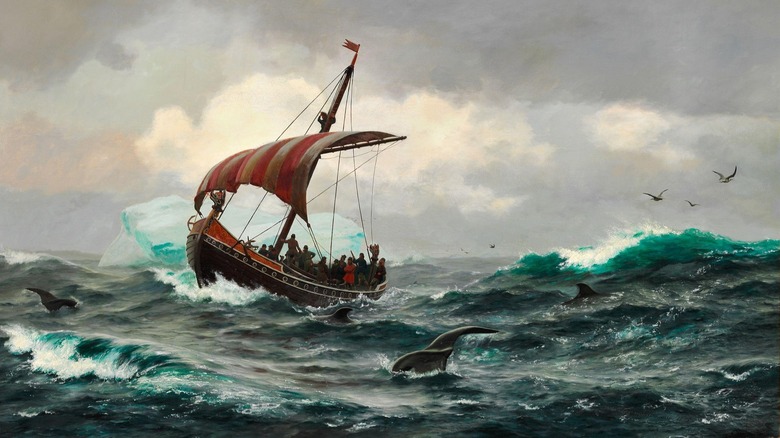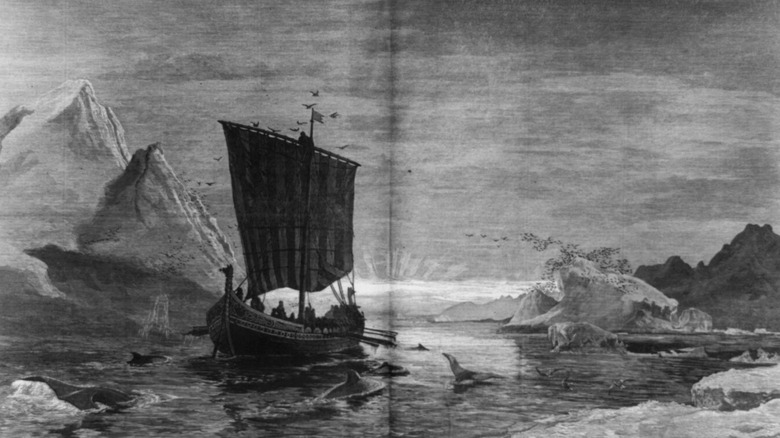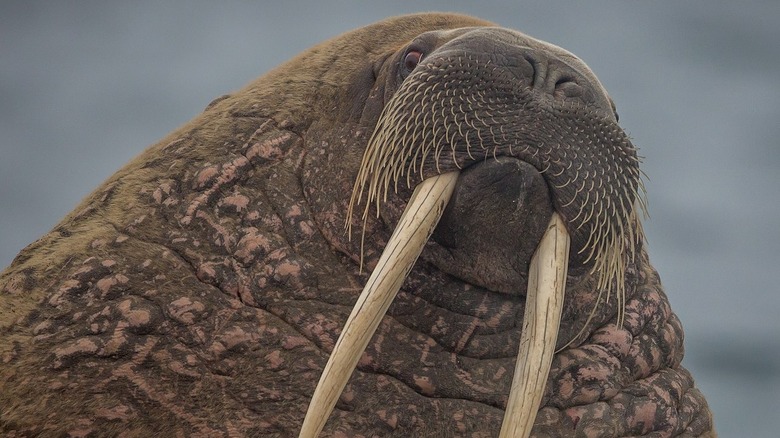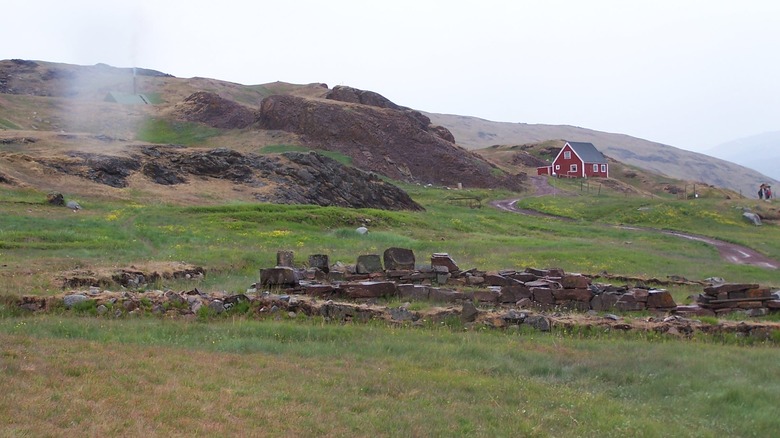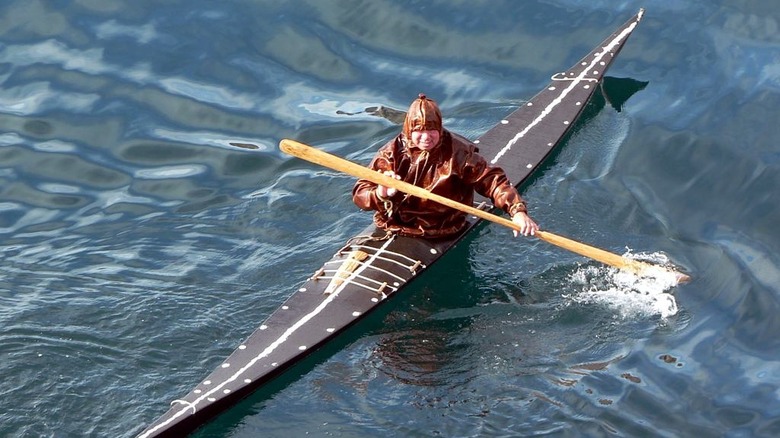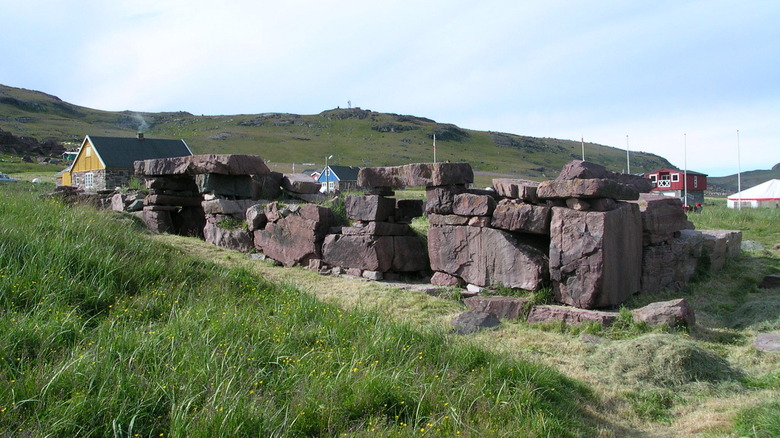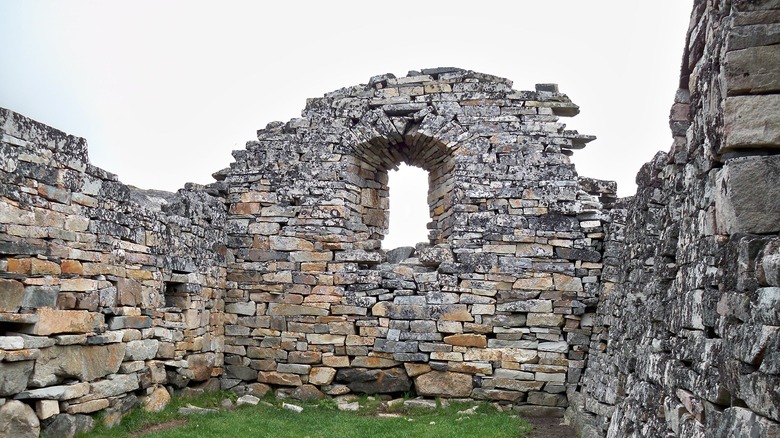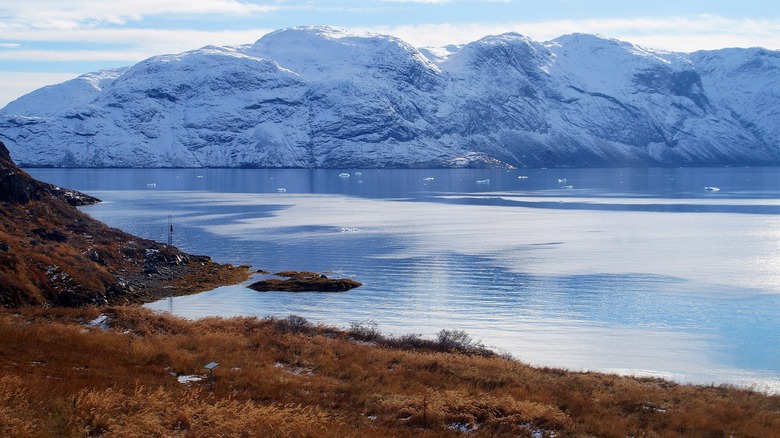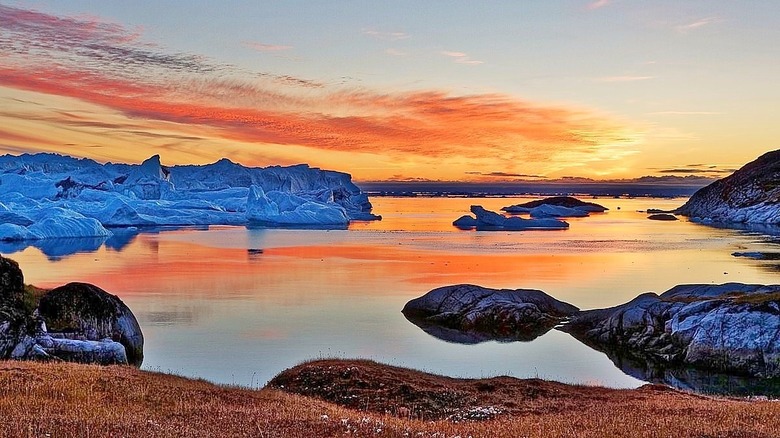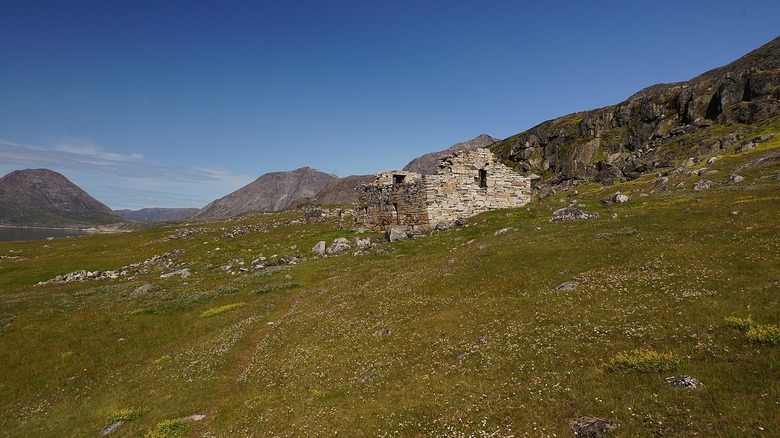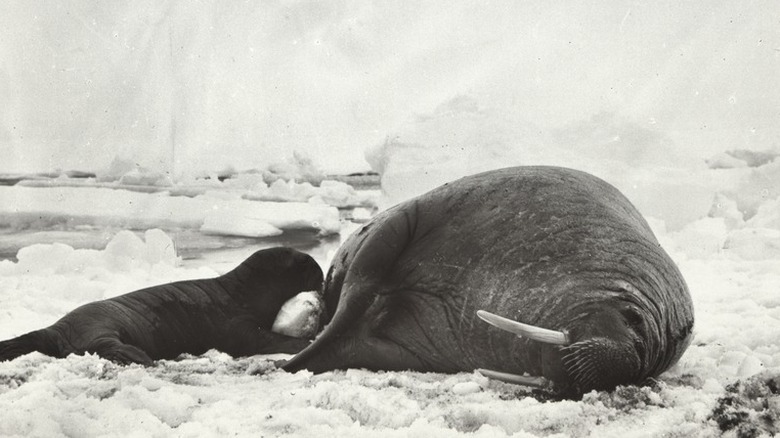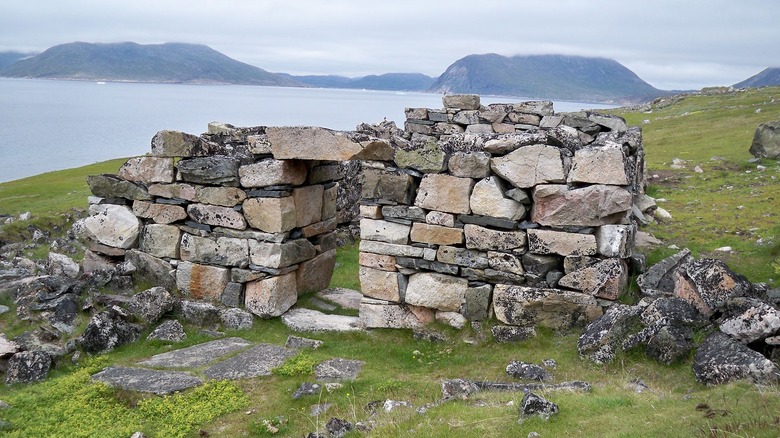Why Greenland's Vikings Disappeared
It sounds like a dark fairy tale. A group of brave adventurers ventures forth into a wild, unforgiving environment, full of snow and ice. They prosper for a while but then, as suddenly as they descended upon the massive island, they disappear. Those who come after them find only silent homesteads devoid of life. Even centuries later, researchers can glean only small details from the remains left behind by the colonists. Where did these people go?
That's certainly how the narrative of the Greenland Vikings goes if you consult sources like Norwegian missionary Hans Egede. According to the World History Encyclopedia, he arrived in Greenland in 1721, the first known European to land there since the local Norse people went quiet in the 15th century. Egede meant to convert the descendants of the Vikings who had settled there many centuries ago, but he was surprised to learn that no one was home. There were only long-abandoned ruins of farms, homes, and churches. After traipsing about the island and finding no one of Scandinavian descent, Egede instead turned his attention to the local Inuit people (via Visit Greenland).
But where had the Vikings gone? And how could an entire group of people disappear? Egede, focused as he was on Christianity and colonization of his own design, didn't really find answers. Later researchers have attempted to tackle these questions. They've gotten closer to solving the mystery, though some of the details still remain out of reach.
Vikings came to Greenland in the 10th century
The Vikings first arrived in Greenland more than 700 years before Egede went looking for their descendants. As Britannica notes, the first colonies on the massive island were established around A.D. 985 by famed Viking explorer Erik the Red. Having been exiled from Iceland after killing a man, Erik found his punishment to be a convenient enough excuse to explore farther to the west. After the initial expedition revealed what seemed like untouched territory, Erik and his men began calling the large island Greenland. They hoped that the verdant name would attract settlers to what was actually a cold, treeless place, with an interior mostly locked in ice. The strategy seemed to work on a few folks, given that about 500 people went back with Erik to colonize the land.
According to the World History Encyclopedia, the scattered homesteads of the Norse were gathered into two broad areas: the southerly Eastern Settlement and the Western Settlement, situated farther to the north along the coast. Setting up along fjords allowed them to take advantage of the small regions that weren't constantly covered in snow, and also gave them relatively easy access to the sea. The settlements were first populated by the relatively rich and powerful who may have wanted to leave cramped Iceland to snag large landholdings. Eventually, the land came under the control of Norway in A.D. 1261, though it was distantly administered.
Walrus ivory was a big deal for the Norse
If anyone was gullible enough to believe Erik the Red's tricky naming of Greenland, they were disabused of that notion as soon as they made landfall. Small groups might eke out a living supported by their livestock, but it was clear that agriculture wasn't going to make any Greenlander rich. How was the colony to support itself instead?
The answer came from the sea, specifically walruses. As per the Royal Society, walrus ivory was a prime export for the Greenlanders — feeding into a European market for luxury goods. It appears to have been so important that it was one of the main economic drivers of Greenland's economy, with archaeological evidence showing that the Norse were hunting the animals for their tusks alone rather than for meat. The Norse would pay taxes and tithes in ivory, also using it to trade for other goods that were scarce in Greenland, like wood and iron (via Science). It was so successful that, up until around A.D. 1400, Greenlanders nearly had a monopoly on the ivory market.
However, it wasn't all easy sailing for the colonists. Issues with supply networks and treacherous sea voyages still made the community and its money-making apparatus vulnerable. As National Geographic reports, rising sea levels and flooding may have cut them off from important trading partners in Norway. With less access to key goods that could only be made off-island, the Greenland Norse could have found themselves in serious trouble.
Farms were a significant part of Norse life on Greenland
For the Norse, attempting agriculture in harsh lands beset by ice and snow wasn't anything new. They almost certainly didn't go to Greenland expecting to grow vast fields of wheat, rye, or other grains. Instead, as the World History Encyclopedia notes, they relied on animal husbandry. This included the relatively tough sheep and goats, which could stand much of the cold temperatures. Farmers might also have cattle, though these more delicate animals had to be brought inside over the harshest periods of the year.
The size of your farm and the livestock one had would have been a way of showing off, demonstrating that a family was so prosperous they could spend the extra time and effort to maintain the more delicate animals. It was indeed a fair amount of effort to keep them. At the end of harsh winters, farmers would move the cattle from their homes to pastures to regain strength (via History on the Net).
All of this meant that dairy and meat formed the cornerstone of the Greenland Norse diet. It still wouldn't have been enough to support the colony at its peak, however. Settlers also turned to native animals like seals and caribou to supplement their diet. Some areas, like Disko Bay, became widely known hunting grounds that supplemented the more traditional Norse way of farming livestock. Furs and animal skins also made up a portion of the colony's exports (via World History Encyclopedia).
Thule Inuit people also moved to Greenland around the same time
Though the Norse may have first assumed that they'd landed on an empty island, it eventually became clear that others had been there long before them, according to the Proceedings of the National Academy of Sciences (PNAS). That would be the people of the Saqqaq culture, which arrived in Greenland about 4,500 years ago. The Dorset culture arrived 2,800 years ago, stuck around for about 600 years, and then seemingly left the island without a trace, possibly pushed out by a changing climate. The Norse then moved in during the 10th century A.D. PNAS estimates that it took about 200 to 300 years for a new group of Inuit, the Thule people, to move in.
Though the Thule were relative newcomers to Greenland, they had a different way of life that may have helped them stay on in the harsh environment even when the Norse found it all but impossible to persist. A study of animal bone fragments found in discard piles, known as middens, indicates that Inuit people may have been under less stress than their Norse neighbors, given how uninterested they seemed to have been in rendering every bit of fat out of animal carcasses (via Arctic Anthropology). It's not exactly a clear-cut conclusion, but the fact that the Thule Inuit live in Greenland to this day, while the Norse faded away, is hard to ignore.
The Norse apparently abandoned Greenland in stages
The dramatic version of this story would have the Norse facing a sudden and devastating blow: a plague, a volcanic eruption, the ground opening up and swallowing every farm and person whole. But, taking even a casual look at the archaeological evidence shows that the decline came slowly.
So did the success of the colony, it seems. The 12th and 13th centuries saw the greatest population in the settlements, a couple of centuries after the first Norse began to set up shop in Greenland. When the end came, it seems to have come nearly as slowly. It took some 300 years for the ivory market to shift away from the once-rich hunting grounds of Greenland and toward African and Russian sources, according to Science. The last records of people living in the Western Settlement trickle in around 1400. The Eastern Settlement was last recorded over 50 years later, in 1450.
The Norse may have starved
The previously accepted version of the Norse disappearance from Greenland holds that environmental changes put considerable pressure on the settlers. But, foolishly clinging to their old ways of living off the land, the people slowly and painfully faced the end. That's the story that was painted by historian and writer Jared Diamond, according to Science. For a while, plenty of researchers had championed the same idea, but more recent research has indicated that Diamond and others may have jumped the gun when they blamed the Norse.
However, there is evidence that the colonists did suffer serious issues with their food supply. According to Science, archaeologists excavating Norse settlements in Greenland have found cut marks on the bones of dogs. Given that dogs were not a traditional food source for the people, this indicates that some were taking desperate measures to stay alive. Insect remains also hint that flies were feeding upon the remains of the dead, perhaps left out in the open when there was no one left to bury them.
Climate change was part of the Vikings' problems
As the once-established scientific thinking went, Norse settlers set themselves up in Greenland during the Medieval Warm Period, when higher than average temperatures made it relatively easy to survive. When the climate began to shift toward colder temperatures, pressure on the Norse increased. Other factors, like an intensifying drought (via The Guardian) and rising sea levels (via American Geophysical Union), brought even more environmental pressure to bear. As if that weren't enough, according to Smithsonian Magazine, the 1257 eruption of Lombok, an Indonesian volcano, spewed climate-cooling ash into the atmosphere.
However, it isn't fair to completely blame climate change for the collapse of the Viking colony. A 2015 study published in Science Advances argues that the Medieval Warm Period wasn't all that warm after all. At least, it wasn't in the Western Atlantic region, which covered Greenland. For the Norse, the plunge into the Little Ice Age may not have presented such a dramatic change as it did for people farther east in mainland Europe. Even the earliest settlers would have had time to adapt to the cool climate. Given how their population would rise over the next couple of centuries, it stands that the icy environment wasn't the impossible challenge that others have painted it. While you can reasonably argue that climate change put considerable pressure on the Greenland Norse, neither is it exactly a smoking gun in the case of the Vikings' disappearance.
The Vikings tried to adapt to Greenland
The classic scenario holds that the Norse stubbornly held to the ways they'd developed during the Medieval Warm Period, paying for it dearly. But a growing body of evidence shows that they took genuine steps to adapt and were still devastated by change.
Their diet, for instance, changed dramatically from what was traditional in even the first few decades of the Norse settlement. More and more people were getting their calories from the ocean rather than the land, as Smithsonian Magazine reports. Traditional Norse diets were heavy on the beef and dairy products, but the Greenlanders' trash heaps show plenty of seal bones, with a scattering of fish parts, too. Chemical analysis of human remains from Norse settlements shows that they were definitely dining on seafood. Essentially, eating fish, seal meat, and other sources of nutrients from the sea leaves a distinct chemical signature in someone's bones that can be read centuries later. In the early days, about 30% to 40% of the Norse diet consisted of sea life. By the end of the settlement, it was more like 80%.
Economics also pushed the Norse out of Greenland
If environmental pressures were all that were faced by the colonists, they might have endured long enough for Hans Egede to find at least a few hangers-on by the 18th century. After all, the Thule Inuit people managed to survive for much longer. There are certainly some indications that the Norse weren't above at least partially adopting their lifestyle, such as their shift toward seal hunting.
But the climate and landscape of Greenland weren't the only things working against the Norse. There was also the economy. Sure, it's not as flashy as volcanic ash filling the sky, but if you've ever worried over a rental bill, or wondered if your paycheck was going to be enough this month, you know how much pressure money woes can exert on a person. For the Greenland Norse, though, it wasn't rent checks causing them trouble. It was the walruses.
By the 15th century, reports Science, the value of ivory had fallen dramatically as other sources from Russian walruses and African elephants began to enter the European market. According to Discover Magazine, elephant ivory had already been around for a couple of centuries and was preferred over the walrus variety, given that elephant tusks were much bigger. The Norse may have also been cut off from trading partners thanks to climate change, which deprived them of vital goods like iron.
The Greenland Norse started to take greater risks
With the price of their once-precious walrus ivory falling, the Greenland Norse apparently chose to double down on the market anyway. They had few other resources that would support the colony to the same extent that a good haul of walrus tusks had done in the past. It was certainly clear that turning to other Greenland-specific goods, like polar bear skins or seal blubber, wasn't nearly enough to keep the colony thriving.
But the push to secure more and more walrus ivory meant that hunters had to put themselves at greater and greater risk. According to Discover Magazine, walrus hunters traveled farther north in this quest than they had usually gone before. This placed them at the mercy of the weather and the icy sea, which could be cruel indeed. Making it to Disko Bay, a popular hunting ground, and going even farther would have meant that the Norse would row through a waterway now called Melville Bay. Centuries later, this area was still known for its treacherous ice floes, which could have caused serious damage to the relatively small boats used by the medieval colonists.
Going farther north than Melville Bay would have placed hunters in calmer waters, but such long expeditions would have taken up valuable time and energy in an already stressed settlement. What's more, losing any member of the small colony, especially one who could bring in valuable income and sustenance through hunting, could have been devastating.
Norse Greenlanders may not have exactly disappeared
Records of some of the last Norse colonists show that not everyone starved to death, or disappeared into the rising seas. In fact, some were celebrating. Such was the case for Sigrid Björnsdóttir and Thorstein Olafsson, the couple who wed at Hvalsey Church in the Eastern Settlement. Their 1408 marriage was one of the very last recorded happenings in the Norse settlement, according to Smithsonian Magazine. Thorstein, a ship's captain, had meant to settle in Iceland, but rough seas had pushed him farther west to Greenland, where he apparently shrugged his shoulders and decided to settle instead.
But the couple didn't perish in Greenland, despite the combined perils of economics, weather, starvation, and the odd murderous polar bear. Instead, they pop up years later in Iceland, both alive and well enough to deal with annoying paperwork. According to "Children of Ash and Elm: A History of the Vikings," later records show that they emigrated to Thorstein's original destination after all. There, they had to prove that they were legally wed back in Greenland. The Icelanders, it appears, may have doubted that Greenland's priests were capable of conducting a proper wedding. It was likely a bother for the couple, but this gives us clear evidence that at least two people safely made it out of Greenland. It's possible that quite a few of the "missing" Vikings simply left Greenland for better opportunities elsewhere.
